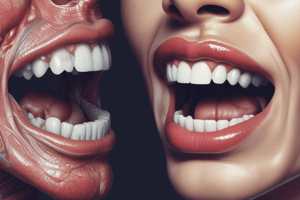Podcast
Questions and Answers
Which structure is described as the tissue that surrounds the cervical part of teeth?
Which structure is described as the tissue that surrounds the cervical part of teeth?
- Floor of the mouth
- Lips
- Tongue
- Gingiva (correct)
What is the principle organ of taste and most important in speech, mastication, and swallowing?
What is the principle organ of taste and most important in speech, mastication, and swallowing?
- Gingiva
- Teeth
- Tongue (correct)
- Cheek
What is the anterior part of the roof of the mouth called?
What is the anterior part of the roof of the mouth called?
- Uvula
- Soft palate
- Hard palate (correct)
- Gingiva
Which process involves the tooth moving from its location within the alveolar crypt into a functional position in the oral cavity?
Which process involves the tooth moving from its location within the alveolar crypt into a functional position in the oral cavity?
Which structure is described as two bilateral bulges caused by the presence of large salivary glands beneath it?
Which structure is described as two bilateral bulges caused by the presence of large salivary glands beneath it?
What is the process of natural physiological elimination of deciduous teeth as a result of resorption of their roots before the eruption of their permanent successors called?
What is the process of natural physiological elimination of deciduous teeth as a result of resorption of their roots before the eruption of their permanent successors called?
What are the two grooves distinguished around lips called?
What are the two grooves distinguished around lips called?
Flashcards are hidden until you start studying
Study Notes
Dental Anatomy and Physiology
- The periodontal ligament structure surrounds the cervical part of teeth.
Oral Cavity
- The tongue is the principle organ of taste and plays a crucial role in speech, mastication, and swallowing.
Palate
- The anterior part of the roof of the mouth is called the primary palate.
Tooth Development
- Eruption is the process that involves the tooth moving from its location within the alveolar crypt into a functional position in the oral cavity.
Facial Structure
- The buccal fat pads are two bilateral bulges caused by the presence of large salivary glands beneath the cheek.
Tooth Development
- Shedding is the process of natural physiological elimination of deciduous teeth as a result of resorption of their roots before the eruption of their permanent successors.
Facial Anatomy
- The two grooves distinguished around the lips are the nasolabial grooves and the labiomental grooves.
Studying That Suits You
Use AI to generate personalized quizzes and flashcards to suit your learning preferences.




